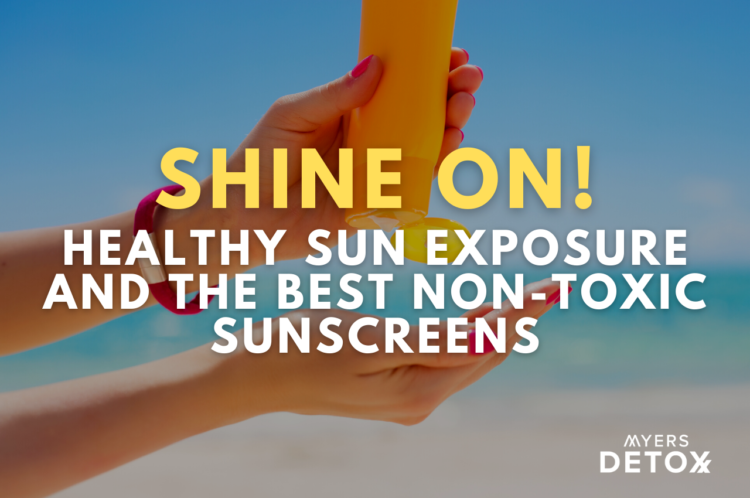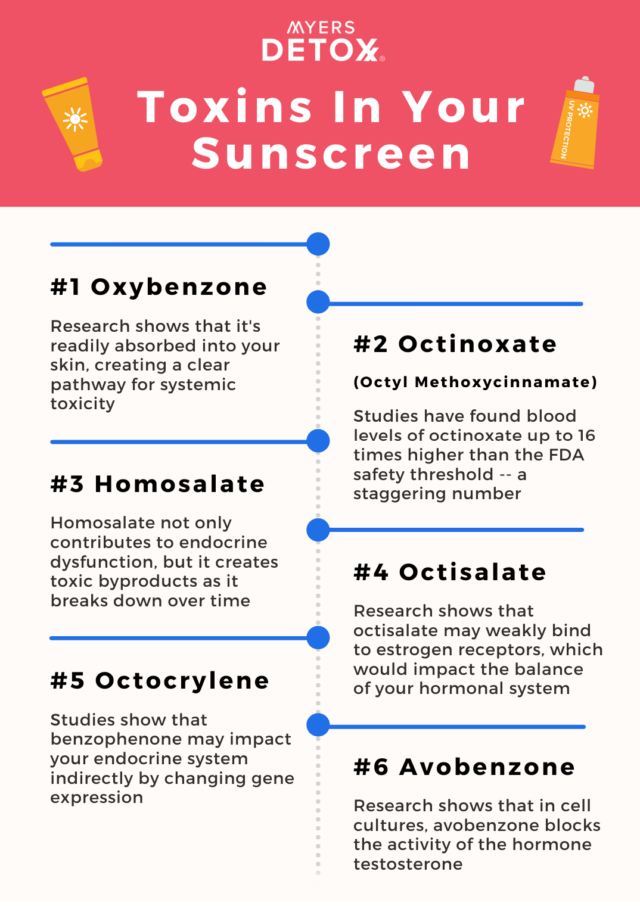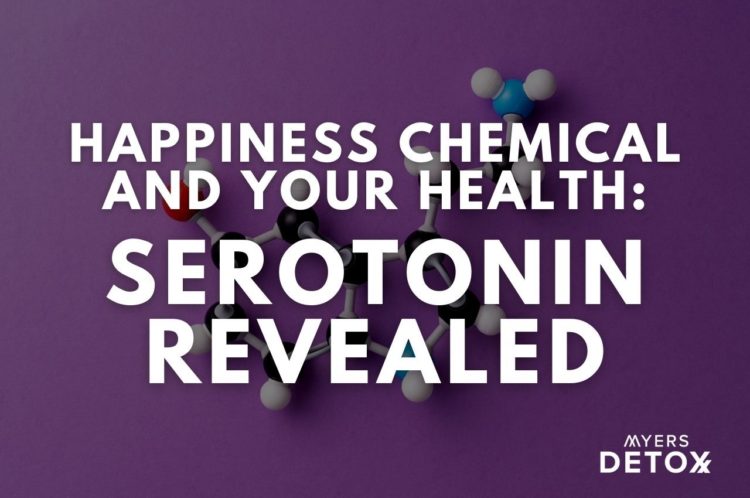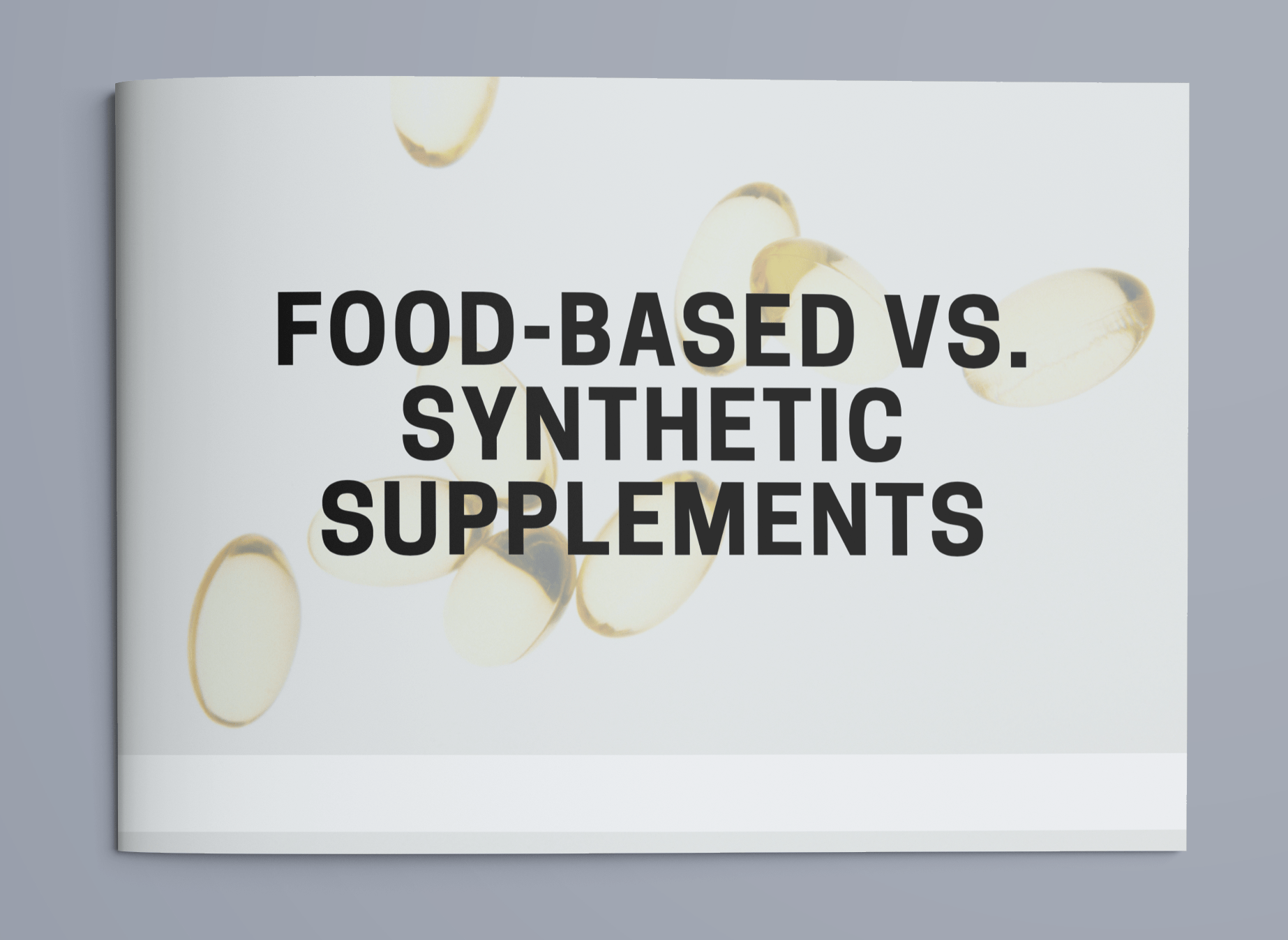Toxic Sunscreen Ingredients to Avoid

Is your sunscreen toxic? Popular opinion would lead you to believe that the best way to protect yourself from skin cancer is to lather up with sunscreen and ward off the dangerous impact of UV rays. Unfortunately, research is showing that although sunscreen is effective at blocking radiation from the sun, it comes with dangerous side effects.
Specifically, the ingredients in most sunscreens are toxic to your health, and many act as endocrine disturbers.
Endocrine disturbing chemicals impact your hormonal system by either mimicking the effects of hormones or blocking hormonal activity.
In this article, you’ll learn:
- Which dangerous toxins are hiding in your sunscreen
- How these chemicals from toxic sunscreens interfere with your hormones
- The detrimental impact that sunscreen has on the environment
- Why it’s crucial to get enough sunlight on your skin
- Non-toxic sunscreen recommendations
Toxins In Your Sunscreen
There are two primary types of sunscreen UV filters — organic and inorganic.
Organic UV filters work by absorbing UV radiation from the sun, while inorganic filters work by reflecting and scattering the radiation.
While organic filters do a fantastic job of absorbing radiation, the chemical compounds in this type of sunscreen are readily absorbed by your skin, creating toxicity in your body. Inorganic filters, on the other hand, are not as easily absorbed and therefore are known to be much less toxic to your body[1].

There are a handful of well-researched organic UV filters that have been studied for their toxic effects. These include[2]:
#1 Oxybenzone
The most well-researched and most troublesome sunscreen ingredient is oxybenzone. This organic filter is one of the most widely used ingredients in commercial sunscreens, and research shows that it’s readily absorbed into your skin, creating a clear pathway for systemic toxicity[1].
One of the major health concerns associated with oxybenzone is its endocrine-disturbing activity. Specifically, research shows[3][4][5][6][7]:
- Adolescent boys with high levels of oxybenzone in their blood have significantly lower testosterone levels.
- Female exposure to oxybenzone has been linked to an increased risk of endometriosis.
- Women exposed to oxybenzone that are carrying male fetuses experience shorter pregnancies.
- A congenital disability called Hirschsprung’s disease has been associated with oxybenzone exposure.
- Unhealthy birth weight (either too low or too high) has been found in babies whose mothers are exposed to oxybenzone.
- Oxybenzone exposure has been linked to breast cancer.
- Animal studies show that exposure to oxybenzone is associated with thyroid tumors and uterine hyperplasia (abnormal cells).
Moreover, several countries have already banned this ingredient due to its detrimental health effects and its toxic impact on the environment.
#2 Octinoxate (Octyl Methoxycinnamate)
Your skin readily absorbs octinoxate, and research shows that it continues to be absorbed for hours after the initial application. Studies have found blood levels of octinoxate up to 16 times higher than the FDA safety threshold — a staggering number.
As another endocrine-disrupting chemical, octinoxate affects thyroid hormone production, inhibiting the synthesis of this crucial compound. In addition, research shows that Octinoxate increases cell proliferation in cells that grow in response to estrogen exposure — a potential risk for breast cancer.
In addition to metabolic and female hormones, octinoxate has been shown to impact sperm count in males and display anti-androgen activity[8].
Some research also suggests that octinoxate may have a neurotoxic effect, impacting neurotransmitters like GABA, glutamate, and aspartate[9].
#3 Homosalate
Homosalate is another widely used organic filter that’s readily absorbed by your skin. While the EU limits the use of homosalate to a concentration of only 1.4%, In the U.S., manufacturers can add up to 15% of this toxic compound.
Homosalate not only contributes to endocrine dysfunction, but it creates toxic byproducts as it breaks down over time[10].
Studies on this harmful compound show[11]:
- The endocrine-disrupting effects of homosalate are particularly concerning since homosalate and other cosmetic UV filters have been identified in human breast milk samples — with one study showing up to 85% of milk contaminated.
- In human breast cancer cells, which grow and multiply in response to estrogen, homosalate exposure led to 3.5 times more cell growth and multiplication.
- In males, the androgen system may be impacted by homosalate.
- In addition to direct health concerns following homosalate exposure, the chemical may also enhance the absorption of pesticides in the body.
#4 Octisalate
Octisalate is absorbed into your skin at ten times above the FDA cutoff for systemic exposure. What’s more, in 2019, the FDA requested additional safety testing for this chemical and stated that there is insufficient data to determine whether octisalate can be classified as safe and effective to use in sunscreens. And yet, it is still a widely used ingredient.
Research shows that octisalate may weakly bind to estrogen receptors, which would impact the balance of your hormonal system[2].
#5 Octocrylene
Octocrylene is absorbed through your skin at levels 14 times higher than the FDA cutoff, and again, the FDA is yet to determine whether this chemical can be classified as safe and effective.
Research shows that octocrylene can degrade into benzophenone over time, which is a derivative of oxybenzone[12]. In addition to all the detrimental effects that oxybenzone exhibits, studies show that benzophenone may impact your endocrine system indirectly by changing gene expression.
What’s more, animal research shows that benzophenone can cause liver hypertrophy and that this chemical can accumulate in the blood, creating toxicity in the liver and kidneys[13].
#6 Avobenzone
Avobenzone is another widely used UV filter that provides protection from UVA rays and is often used with other filters to offer more broad-spectrum protection from the sun.
Research shows that in cell cultures, avobenzone blocks the activity of the hormone testosterone. Furthermore, it appears that when combined with other common ingredients found in sunscreen, avobenzone exhibits glucocorticoid-like activity. Glucocorticoids play an important role in inflammation, immunity, and the breakdown of nutrients in your body[14].
Safer Alternatives to Toxic Sunscreens
Titanium dioxide and zinc oxide offer safer alternatives to the above chemicals. These compounds are inorganic UV filters which reflect and scatter sunlight, as opposed to absorbing it.
Titanium Dioxide – Still Potentially Toxic
There is some debate as to whether titanium dioxide is safe. It is found in many natural sunscreens. The Environmental Working Group says that “Titanium dioxide is a possible human carcinogen, but only for inhalation and products that may be aerosolized (airborne). It appears to have low skin penetration, but inhalation is a concern.” So, I think it is likely safe in a sunscreen lotion.
Nanoparticle or micronized titanium dioxide, however, is concerning. Nanoparticles of titanium dioxide are used in sunscreens because they are colorless at that size and still absorb ultraviolet light. While many are praising this new technology, others are warning of its inherent dangers to our bodies.
A study by Churg et al. at the University of British Columbia, “Induction of Fibrogenic Mediators by Fine and Ultrafine Titanium Dioxide in Rat Tracheal Explants” (1999) found that ultrafine particles of the anatase form of titanium dioxide, which are less than 0.1 microns, are pathogenic or disease-causing. Other studies have found that the smaller the particle size, the more toxic the mineral[15].
Nanoparticle titanium dioxide penetrates the cells and can cause DNA damage after exposure to sunlight (Powell, et. al. 1996). The fear is that this could lead to cancer in the skin.
Coarse or fine particles of titanium dioxide are safe and effective at deflecting and absorbing UV light, but consumers should avoid using micronized titanium dioxide, either in sunscreens or cosmetics[16].
Zinc Oxide
Zinc oxide is the most effective and safest mineral UV filter. Zinc sits on top of your skin and prevents UV damage, acting as a physical barrier. It’s just as effective as a chemical filter like oxybenzone without the toxic side effects.
If you’ve already got enough unfiltered sunlight for the day’s vitamin D needs and want some UV protection, zinc oxide is your best, safest bet.
Mark Sisson thinks that nanoparticle zinc is safe. “If you’re worried about looking silly with white streaks all over your face and body, you can opt for safe nanoparticle zinc oxide that disappears on your skin. There is some concern that these nanoparticles of zinc oxide can cause health problems, but the evidence seems to weigh heavily toward the ‘all safe’ side[17].
One study found that while zinc oxide does penetrate some of the outer layers of the epidermis (more so when the skin is sunburnt), it does not achieve transdermal penetration for systemic distribution[18].”
The Importance Of Healthy Sun Exposure
While there are plenty of toxin-free sunscreens out there, there is one more crucial topic to cover before you go covering every inch of your body with a more natural product, and that’s the fact that sun exposure is crucial for your health.
Of course, you don’t want to overdo it and burn your skin, but getting natural sunlight on your body every day is vital to overall well being.
First, sunlight is crucial for the natural production of vitamin D, which many people are deficient in. Vitamin D is essential for calcium absorption in your body and helps to maintain calcium and phosphorous levels — vital for healthy bones.
In addition, vitamin D plays a role in immunity, inflammation, neuromuscular function, and glucose metabolism[19].
Aside from its role in vitamin D synthesis, sunlight also impacts[20]:
- Your circadian rhythm
- The production of melatonin (sleep hormone)
- The production of serotonin (feel-good hormone)
- Immune processes that prevent autoimmune disease
- Gene repair, reducing melanoma risk
- Stress-response by increasing endorphins
Environmental Impact Of Sunscreen
The dangers of the harmful chemicals in your sunscreen aren’t limited to your body. When you swim in the ocean or even take a shower after a day in the sun, these chemicals can leach into the water supply.
Research shows that the same chemicals that have a dangerous impact on your health may also negatively affect marine life — specifically coral reefs. Some of the ways these compounds impact the health of our oceans include[21]:
- Impaired growth and synthesis of green algae.
- Accumulation in the tissue of coral, damaging the coral reefs and creating bleaching, DNA damage, and sometimes even killing the coral altogether.
- Induce birth defects in mussels.
- Damaged immune and reproductive systems in sea urchins.
- Decreased fertility in fish, with female fish displaying male characteristics.
- Accumulation in the tissues of dolphins, which can then transfer to their young.
Oxybenzone, in particular, has a devastating impact on coral reefs. By making the water around the corals toxic, it inhibits their symbiotic relationship with algae. It’s the algae in the waters that give the coral reefs their beautiful color, and the result of this toxic insult is bleached reefs. What’s even more disturbing, the absence of algae, and the subsequent bleaching leaves the coral more vulnerable to diseases, which ultimately leads to their death[3].
Aside from the crucial role that coral reefs play in the ocean’s ecosystem, they also provide food, income, and protection to over half a billion people worldwide. Everything from fishing to diving to snorkeling can be enjoyed by tourists when they visit these beautiful coral reefs and supply the locals with a steady source of income. When these reefs are damaged, the ripple effect beyond the environmental concerns is substantial[22].
My Top Non-Toxic Sunscreen Recommendations
Living Libations – Living Libations is devoted to celebrating the lifeforce of people, plants, and the planet. They ensure good manufacturing practices and include only the highest quality ingredients. They attest to their global responsibility to maintain the health of the planet while bringing you products that are not only clean but highly effective.
I love their zinc lotion sunscreen, it not only offers long-lasting protection from the sun but is infused with moisturizing oils to keep your skin glowing and soft.
Creatrix Solutions Tallow Sunscreen – Creatrix Solutions offers a range of products for toxic-free living. Their tallow sunscreen forms a protective barrier, while its nourishing ingredients hydrate, moisturize and promote healthy skin. Their tallow is grass-fed and contains no hormones or antibiotics whatsoever.
Annmarie Skin Care – All of Annmarie’s products are fantastic, and their sunscreen is no different. I like it because it has a tint to hide the whitening effect of zinc oxide.
Sun Protection from Beautycounter – The Sun Protection collection from Beautycounter uses non-nano zinc oxide, a safer and effective alternative to oxybenzone, and keeps you covered without concern.
MyChelle Sun Shield SPF 28 Coconut Sunscreen – I love the mild pleasant coconut scent, but they have unscented as well. I DON” T like their spray sunscreen as it turns your skin pure white. I hope they tweak the spray formula soon to fix this!
Goddess Garden SPF 30 Everyday Natural Sunscreen Continuous Spray – I love this one because it doesn’t go on WHITE like other natural spray sunscreens. I like all the other goddess garden lines of sunscreens.
Badger Balm – All their products are good, but the sunscreens are the most renowned. They are very thorough with the science behind their sunscreens, and they run regular tests to confirm the safety of their zinc oxide formula. Best of all, they’ve managed to minimize the whitening without increasing the potential for toxicity.
Raw Elements Eco Formula – Active ingredient is zinc oxide. It’s thick but stays on well even with water exposure and activity. Not too whitening either.
Kabana Skincare – Another good sunscreen source that uses zinc oxide. They’ve even got a formula with added vitamin D, presumably to make up for the UVB you’re blocking. Not sure if that actually works, but it certainly can’t hurt.
Takeaway
The way in which we’ve been trained to use sunscreen to protect ourselves from the dangerous threats of sun exposure may do much more harm than good.
First of all, you need sun exposure for various reasons — vitamin D synthesis being chief among them.
And second, and perhaps even more important, is the toxic nature of most of the sunscreens on the market.
To protect yourself and your family from toxic sunscreen, always look at the ingredients on the labels of your sunscreens. If you see any of the following, avoid them and choose an alternative:
- Oxybenzone
- Octinoxate
- Homosalate
- Octisalate
- Octocrylene
- Avobenzone
If you want to save yourself some time and headache, go with one of my recommendations either above or in this article. These companies pass my test for purity and quality.
Click Here for References+
- Matta, Murali K., et al. “Effect of sunscreen application on plasma concentration of sunscreen active ingredients: a randomized clinical trial.” Jama 323.3 (2020): 256-267.
- https://www.ewg.org/sunscreen/report/the-trouble-with-sunscreen-chemicals/
- https://www.mbnep.org/2019/06/11/the-truth-about-sunscreen-its-effects-on-us-and-the-environment/
- Scinicariello, Franco, and Melanie C. Buser. “Serum testosterone concentrations and urinary bisphenol A, benzophenone-3, triclosan, and paraben levels in male and female children and adolescents: NHANES 2011–2012.” Environmental health perspectives 124.12 (2016): 1898-1904.
- Kunisue, Tatsuya, et al. “Urinary concentrations of benzophenone-type UV filters in US women and their association with endometriosis.” Environmental science & technology 46.8 (2012): 4624-4632.
- https://www.niehs.nih.gov/research/supported/centers/breast-cancer/grantees/msu/index.cfm
- DiNardo, Joseph C., and Craig A. Downs. “Can oxybenzone cause Hirschsprung’s disease?.” Reproductive Toxicology 86 (2019): 98-100.
- https://www.safecosmetics.org/get-the-facts/chemicals-of-concern/octinoxate/
- Ruszkiewicz, Joanna A., et al. “Neurotoxic effect of active ingredients in sunscreen products, a contemporary review.” Toxicology Reports 4 (2017): 245-259.
- https://ec.europa.eu/health/ph_risk/committees/04_sccp/docs/sccp_o_097.pdf
- https://www.safecosmetics.org/get-the-facts/chemicals-of-concern/homosalate/#_edn11
- https://pubs.acs.org/doi/10.1021/acs.chemrestox.0c00461
- https://www.safecosmetics.org/get-the-facts/chemicals-of-concern/benzophenone/
- Klopčič, Ivana, and Marija Sollner Dolenc. “Endocrine activity of AVB, 2MR, BHA, and their mixtures.” Toxicological Sciences 156.1 (2017): 240-251.
- Churg, A., B. Gilks, and J. Dai. “Induction of fibrogenic mediators by fine and ultrafine titanium dioxide in rat tracheal explants.” American Journal of Physiology-Lung Cellular and Molecular Physiology 277.5 (1999): L975-L982.
- Kang, Su Jin, et al. “Titanium dioxide nanoparticles trigger p53‐mediated damage response in peripheral blood lymphocytes.” Environmental and molecular mutagenesis 49.5 (2008): 399-405.
- Nohynek, Gerhard J., and Eric K. Dufour. “Nano-sized cosmetic formulations or solid nanoparticles in sunscreens: a risk to human health?.” Archives of toxicology 86.7 (2012): 1063-1075.
- Monteiro-Riviere, Nancy A., et al. “Safety evaluation of sunscreen formulations containing titanium dioxide and zinc oxide nanoparticles in UVB sunburned skin: an in vitro and in vivo study.” Toxicological sciences 123.1 (2011): 264-280.
- https://ods.od.nih.gov/factsheets/VitaminD-HealthProfessional/
- Mead, M. Nathaniel. “Benefits of sunlight: a bright spot for human health.” (2008): A160-A167.
- https://oceanservice.noaa.gov/news/sunscreen-corals.html
- https://www.noaa.gov/education/resource-collections/marine-life/coral-reef-ecosystems#:~:text=Benefits%20of%20coral%20reef%20ecosystems,food%2C%20income%2C%20and%20protection








